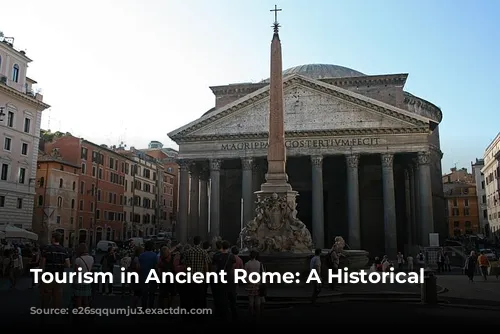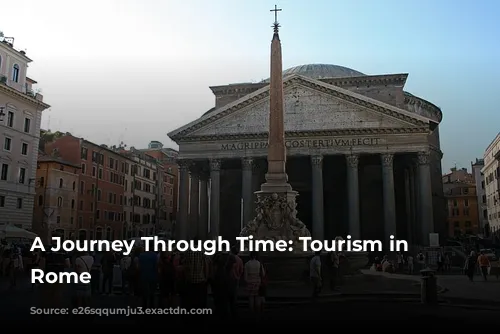Imagine a world without airplanes, where the only way to travel was by foot, horse, or boat. This was the reality for people in Ancient Rome. But even without modern conveniences, tourism flourished, playing a vital role in the city’s economy, culture, and global influence.

The Rise of Roman Tourism
Ancient Rome was a bustling metropolis attracting visitors from across the known world. People came to witness the city’s grandeur, immerse themselves in its vibrant culture, and marvel at its architectural masterpieces. The Colosseum, the Pantheon, and the Roman Forum, testaments to Roman engineering and ingenuity, drew crowds eager to experience history firsthand.
Entertainment was a cornerstone of Roman life, and tourism played a key role in fueling this passion. The city boasted numerous theaters, amphitheaters, and other venues where gladiatorial games, chariot races, and theatrical performances captivated audiences. These events were major draws for tourists, who flocked to Rome to witness these spectacles.
A Golden Age of Tourism
Under the reign of Augustus (27 BC to 14 AD), Rome experienced a “golden age” of tourism. The city’s population skyrocketed, making it a center of trade, commerce, and culture. Augustus, a visionary leader, launched numerous public works projects, including roads, aqueducts, and public buildings, which improved the city’s infrastructure and made it more accessible to visitors.
Rome’s rich history and cultural heritage were also major attractions. Visitors flocked to see the ruins of ancient temples, palaces, and public buildings, immersing themselves in the past.
The Evolution of Tourism in Ancient Rome
Tourism in Ancient Rome evolved over time, reflecting the changing historical and cultural landscape.
- The Republic (509-27 BC): During this era, tourism primarily revolved around religious pilgrimages and political events, such as elections and public assemblies.
- The Empire (27 BC-476 AD): Under the Roman Empire, tourism became more organized and commercialized. The emergence of guidebooks, travel agencies, and lodging facilities transformed the industry.
- Late Antiquity (4th-6th centuries AD): The decline of the Roman Empire led to political instability and economic downturn, impacting tourism. The rise of Christianity led to the closure of many pagan temples and public buildings, further impacting the industry.
Despite these fluctuations, tourism remained an integral part of Ancient Rome’s economy and identity.
Travel and Accommodation in Ancient Rome
Ancient Rome’s extensive network of roads, a testament to Roman engineering prowess, made travel easier and more accessible. These roads, built with multiple layers of gravel, sand, and cement, were durable, well-maintained, and capable of handling heavy traffic.
Travelers had a variety of accommodation options. Inns, often run by families, were available in most towns and cities along the roads, providing basic lodging and meals. These affordable inns offered essential amenities like beds, tables, and chairs, and some even provided entertainment like music and dancing.
For wealthy travelers, private homes or villas were available for rent, offering a more luxurious and personalized experience. However, these options were significantly more expensive and only accessible to a select few.
The Economic Impact of Tourism in Ancient Rome
Tourism was a significant contributor to the economy of Ancient Rome. The city was a popular destination for travelers from across the world, and the industry was a major source of income, employing a large number of people.
Tourism spurred an increase in trade and commerce. Merchants and traders sold their goods to tourists, creating a thriving marketplace. Souvenirs, such as pottery, jewelry, and figurines, were popular purchases, providing income to local artisans.
The entertainment industry also benefitted greatly from tourism. Gladiatorial games, chariot races, and theatrical performances were major attractions for both locals and visitors. These events, held in large venues like the Colosseum and Circus Maximus, drew enormous crowds, generating significant revenue.
Cultural Exchange: A Legacy of Tourism
Tourism in Ancient Rome wasn’t just about sightseeing; it was also about cultural exchange. Visitors from different parts of the world came to Rome to learn about its culture, art, and architecture. In turn, they brought their own cultures and traditions to Rome.
Visitors were influenced by the Roman way of life, learning about Roman art, literature, philosophy, and engineering. They were amazed by the grandeur of Roman architecture. They also absorbed knowledge of Roman law, which had a lasting influence on legal systems worldwide.
Religious pilgrimages were also a significant part of tourism. People traveled to Rome to visit holy sites of Christianity, such as the catacombs, the Basilica of St. Peter, and the Vatican. Pilgrims brought with them their own religious traditions, influencing the development of Christianity in Rome.
The cultural exchange that occurred during tourism in Ancient Rome shaped the world we live in today. It facilitated the spread of knowledge, ideas, and traditions, playing a crucial role in the development of art, architecture, law, and religion.
Ancient Rome: A Pioneer in Tourism
From religious pilgrimages to grand spectacles, tourism in Ancient Rome was a powerful force. It shaped the city’s economy, culture, and identity, leaving a lasting legacy on the world. While modern tourism may look vastly different, the fundamental principles of travel and exploration remain the same. Ancient Rome serves as a reminder that the desire to discover new places and cultures is a timeless human instinct.
